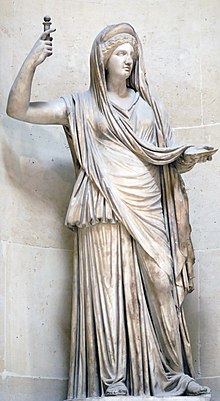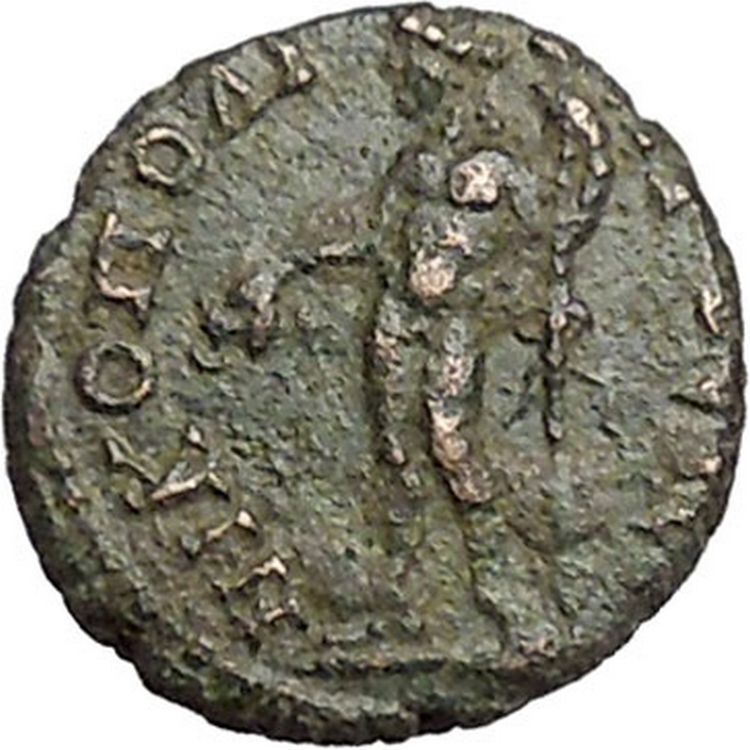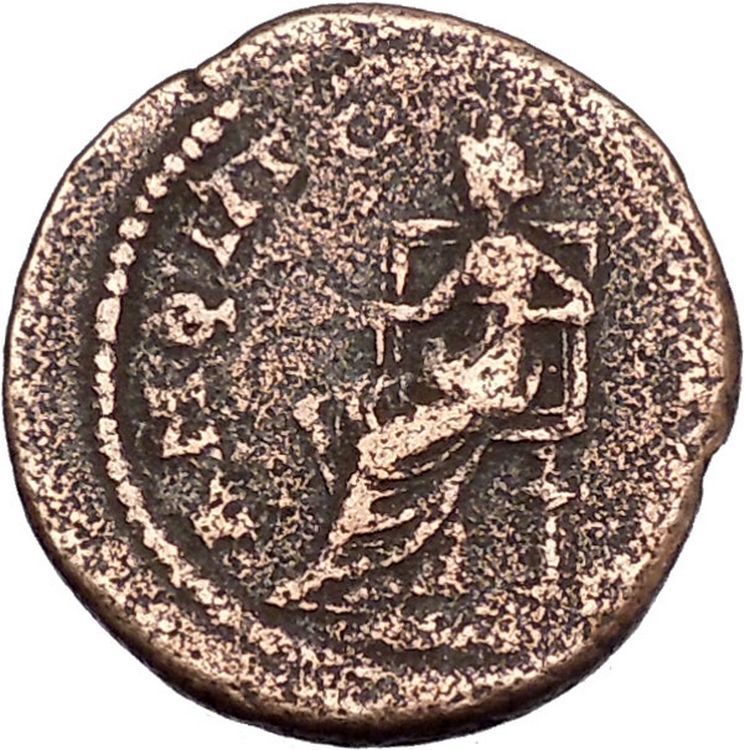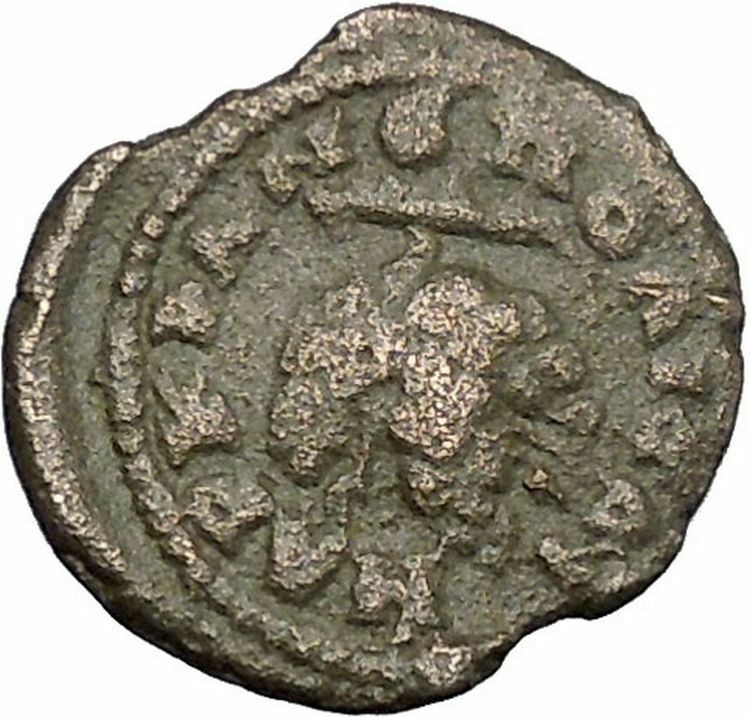|
Philip II – Caesar: 244-247 & Roman Emperor: 247-249 A.D.
Bronze Pentassasrion 26mm (11.48 grams) of Marcianopolis in Moesia Inferior
Certification: NGC Ancients VF 4285241-015
KAICAP M IOVΛIOC ΦIΛIΠΠOC AVΓ, Bare-headed draped bust of Philip and turreted, draped bust of Serapis facing each other.
MAPKIANOΠOΛEITΩN•, Hera standing facing, head to left, holding patera with right hand, and scepter with left, E (mark of value) in left field.
You are bidding on the exact item pictured, provided with a Certificate of Authenticity and Lifetime Guarantee of Authenticity.
 Serapis (Latin spelling, or Sarapis in Greek) was a syncretic Hellenistic-Egyptian god in Antiquity. His most renowned temple was the Serapeum of Alexandria. Under Ptolemy Soter, efforts were made to integrate Egyptian religion with that of their Hellenic rulers. Ptolemy’s policy was to find a deity that should win the reverence alike of both groups, despite the curses of the Egyptian priests against the gods of the previous foreign rulers (i.e Set who was lauded by the Hyksos). Alexander the Great had attempted to use Amun for this purpose, but he was more prominent in Upper Egypt, and not as popular with those in Lower Egypt, where the Greeks had stronger influence. The Greeks had little respect for animal-headed figures, and so a Greek-style anthromorphic statue was chosen as the idol, and proclaimed as the equivalent of the highly popular Apis. It was named Aser-hapi (i.e. Osiris-Apis), which became Serapis, and was said to be Osiris in full, rather than just his Ka (life force). Serapis (Latin spelling, or Sarapis in Greek) was a syncretic Hellenistic-Egyptian god in Antiquity. His most renowned temple was the Serapeum of Alexandria. Under Ptolemy Soter, efforts were made to integrate Egyptian religion with that of their Hellenic rulers. Ptolemy’s policy was to find a deity that should win the reverence alike of both groups, despite the curses of the Egyptian priests against the gods of the previous foreign rulers (i.e Set who was lauded by the Hyksos). Alexander the Great had attempted to use Amun for this purpose, but he was more prominent in Upper Egypt, and not as popular with those in Lower Egypt, where the Greeks had stronger influence. The Greeks had little respect for animal-headed figures, and so a Greek-style anthromorphic statue was chosen as the idol, and proclaimed as the equivalent of the highly popular Apis. It was named Aser-hapi (i.e. Osiris-Apis), which became Serapis, and was said to be Osiris in full, rather than just his Ka (life force).
 Hera is the wife and one of three sisters of Zeus in the Olympian pantheon of Greek mythology and religion. Her chief function is as the goddess of women and marriage. Her counterpart in the religion of ancient Rome was Juno. The cow, lion and the peacock are sacred to her. Hera’s mother is Rhea and her father Cronus. Hera is the wife and one of three sisters of Zeus in the Olympian pantheon of Greek mythology and religion. Her chief function is as the goddess of women and marriage. Her counterpart in the religion of ancient Rome was Juno. The cow, lion and the peacock are sacred to her. Hera’s mother is Rhea and her father Cronus.
Portrayed as majestic and solemn, often enthroned, and crowned with the polos (a high cylindrical crown worn by several of the Great Goddesses), Hera may bear a pomegranate in her hand, emblem of fertile blood and death and a substitute for the narcotic capsule of the opium poppy. A scholar of Greek mythology Walter Burkert writes in Greek Religion, “Nevertheless, there are memories of an earlier aniconic representation, as a pillar in Argos and as a plank in Samos.”
Hera was known for her jealous and vengeful nature, most notably against Zeus’s lovers and offspring, but also against mortals who crossed her, such as Pelias. Paris offended her by choosing Aphrodite as the most beautiful goddess, earning Hera’s hatred.
Marcianopolis, or Marcianople was an ancient Roman city in Thracia. It was located at the site of modern day Devnya, Bulgaria.
The city was so renamed by Emperor Trajan after his sister Ulpia Marciana, and was previously known as Parthenopolis. Romans repulsed a Gothic attack to this town in 267 (or 268), during the reign of Gallienus. Diocletian made it the capital of the Moesia Secunda province.
Valens made it his winter quarters in 368 and succeeding years, Emperor Justinian I restored and fortified it. In 587, it was sacked by the king of the Avars but at once retaken by the Romans. The Roman army quartered there in 596 before crossing the Danube to assault the Avars.
Between 893 and 972 it was one of the most important medieval cities in south-eastern Europe.
 Philip II – 247-249 A.D. Philip II – 247-249 A.D.
Caesar: 244-247 A.D. (under Philip I) | Augustus: 247-249 A.D. (with Philip I)
Son of Philip I ‘The Arab’ and Otacilia Severa | Grandson of Julius Marinus
Marcus Julius Philippus Severus, also known as Philippus II, Philip II and Philip the Younger (238-249) was the son and heir of the Roman Emperor Philip the Arab by his wife Roman Empress Marcia Otacilia Severa. According to numismatic evidence, he had a sister called Julia Severa or Severina, whom the ancient Roman sources do not mention.
When his father became emperor in 244 he was appointed Caesar. Philippus was consul in 247 and 248. His father was killed in battle by his successor Decius in 249. When news of this death reached Rome, he was murdered by the Praetorian Guard. He died in his mother’s arms. When he died, he was eleven years old.
|









 Serapis (Latin spelling, or Sarapis in Greek) was a syncretic Hellenistic-Egyptian god in Antiquity. His most renowned temple was the Serapeum of Alexandria. Under Ptolemy Soter, efforts were made to integrate Egyptian religion with that of their Hellenic rulers. Ptolemy’s policy was to find a deity that should win the reverence alike of both groups, despite the curses of the Egyptian priests against the gods of the previous foreign rulers (i.e Set who was lauded by the Hyksos). Alexander the Great had attempted to use Amun for this purpose, but he was more prominent in Upper Egypt, and not as popular with those in Lower Egypt, where the Greeks had stronger influence. The Greeks had little respect for animal-headed figures, and so a Greek-style anthromorphic statue was chosen as the idol, and proclaimed as the equivalent of the highly popular Apis. It was named Aser-hapi (i.e. Osiris-Apis), which became Serapis, and was said to be Osiris in full, rather than just his Ka (life force).
Serapis (Latin spelling, or Sarapis in Greek) was a syncretic Hellenistic-Egyptian god in Antiquity. His most renowned temple was the Serapeum of Alexandria. Under Ptolemy Soter, efforts were made to integrate Egyptian religion with that of their Hellenic rulers. Ptolemy’s policy was to find a deity that should win the reverence alike of both groups, despite the curses of the Egyptian priests against the gods of the previous foreign rulers (i.e Set who was lauded by the Hyksos). Alexander the Great had attempted to use Amun for this purpose, but he was more prominent in Upper Egypt, and not as popular with those in Lower Egypt, where the Greeks had stronger influence. The Greeks had little respect for animal-headed figures, and so a Greek-style anthromorphic statue was chosen as the idol, and proclaimed as the equivalent of the highly popular Apis. It was named Aser-hapi (i.e. Osiris-Apis), which became Serapis, and was said to be Osiris in full, rather than just his Ka (life force).  Hera is the wife and one of three sisters of Zeus in the Olympian pantheon of Greek mythology and religion. Her chief function is as the goddess of women and marriage. Her counterpart in the religion of ancient Rome was Juno. The cow, lion and the peacock are sacred to her. Hera’s mother is Rhea and her father Cronus.
Hera is the wife and one of three sisters of Zeus in the Olympian pantheon of Greek mythology and religion. Her chief function is as the goddess of women and marriage. Her counterpart in the religion of ancient Rome was Juno. The cow, lion and the peacock are sacred to her. Hera’s mother is Rhea and her father Cronus. Philip II – 247-249 A.D.
Philip II – 247-249 A.D.




